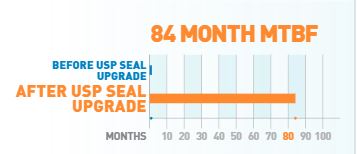September 9, 2019 | 2 minute read
A jack-up oil unit serving the Harding Field in the Central North Sea was experiencing frequent unplanned test separator pump failures caused by the combination of high levels of corrosive naphthenic acid and sandy conditions. The platform’s test separator pump performs a critical function by monitoring well fluids, ultimately determining which well to pump oil and gas and water from, and at what rate.
The oil company grew concerned about rising costs and labor hours required to frequently change the mechanical seals within the pump, as well as potential lost production.
John Crane’s Expertise
The company relied on John Crane’s knowledge and experience to provide a reliable alternative to existing mechanical seals. After a comprehensive analysis of the failed test separator pump seals, John Crane determined that the process fluid properties and contaminants caused an unacceptable MTBF rate. With a long history of oil and gas industry knowledge, coupled with expertise on corrosive fluid applications, John Crane recommended an alternative to mechanical seals that use the process fluid as the interface fluid.
The solution would replace the standard dual-unpressurized seals with a tested, innovative face treatment to reliably handle the less-than-ideal fluid conditions.
Sealing Solution

With non-saline water in short supply, extensive testing was required to determine if the seals would operate using filtered seawater as a barrier fluid. This would set up a sealed gap that eliminated physical contact of the faces during operation to form a sealing dam when stationary.
Upon receiving satisfactory test results, a second seal in cartridge form was added to contain the barrier fluid, allowing little or no leakage at the outboard seal at or slightly above atmospheric pressure.
Dramatic Results
